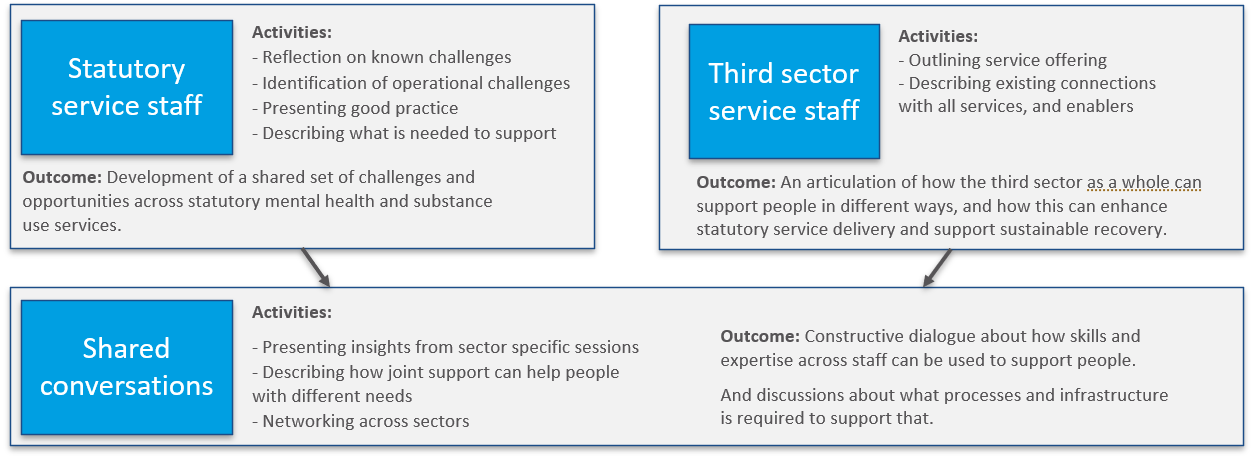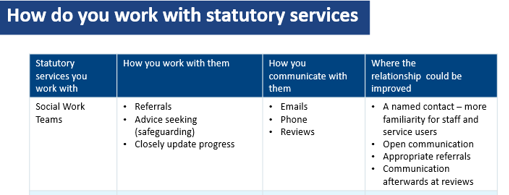Strategic Planning: Staff Conversations
About Staff Conversations
Through structured conversations with staff across sectors and services, you can surface challenges faced by staff in supporting, and getting support for, people with co-occurring conditions, develop a shared understanding of the roles of different services (especially useful with regards to third sector services) and build relationships between staff. This can support:
- Building shared understanding of the different service that support people will co-occurring conditions and what they do,
- Developing consensus around shared challenges in supporting co-occurring conditions, and
- Identification of opportunities for collaboration.

Supporting protocol – how you might use this tool:
When looking at adapting and implementing a local mental health and substance use protocol, this tool can:
Build relationships between staff who will be working together around new pathways/interfaces
Develop and co-create scenarios on how they might work together to support different dynamics of co-occurring conditions, to form high level local pathways
Bring third sector services into a collaborative space to explore how best to utilise these broad services alongside statutory services
The insights developed from these sessions can help identify a core template for how services can interface, including - good practice to spread, priorities for pathway development and challenges that need escalating to a strategic level.
Structured Conversations
As part of the Mental Health and Substance Use Pathfinder Programme, HIS facilitated a series of staff conversations as a way to understand the experiences of delivering care and support including identifying good practice, build constructive dialogue around supporting co-occurring needs within separate services, and outline how new pathways can improve care.
Where you are bringing together different staff groups, it can be beneficial to have separate sessions prior to a shared conversation. This provides a safe space for staff to highlight challenges, and develop a collective view on certain topics.
Statutory Service Staff
The aim of this session with statutory service staff is to agree and articulate a shared set of challenges and opportunities related to supporting people with co-occurring conditions.
Planning your session
Prepare an introduction that includes the findings from any staff engagement already undertaken. This will help set the context for the discussions within the session.
Agree any specific areas you would like to focus on based on what you are trying to achieve and the above.
Who should be involved
- Staff from both mental health and substance use services, including:
- Nursing staff
- Social work staff
- Psychiatrists
- Team leads
- Where appropriate, staff from additional statutory services such as any liaison or outreach teams, or acute services.
Activities
Depending on how well staff know each other, it might be useful to start with an activity to get to know each other’s services. This discussion tool can be found here.
The core activity within this workshop is open discussions. In groups of up to 6, discuss:
- What are the main challenges in getting people the right support at the right time?
- What obstacles or challenges do you face in linking with other services?
- How might we build capacity within services to support mental health or substance use?
- Where would you like to see improvements made?
Slides from the staff conversation workshop
Outputs
Where this has been done before, key themes include:

You can find the outputs from Statutory Service Staff discussion sessions here.
Supporting resources for this tool
-
Agendas and slides:
Third Sector Staff Conversations
The aim of this session is to develop an articulation of how the third sector as a whole can support people in different ways, and how this can enhance the impact of statutory services and support sustainable recovery.
Planning your session
Prepare an introduction that includes the findings from any engagement already undertaken. This will help sent the context for the discussion.
Who should be involved
Staff from a range of third sector organisations that support people with mental health and substance use support needs. This should include:
- Case holding services (such as Penumbra)
- Peer led services (such as recovery communities)
- Advocacy
Activities
Discussion One – getting to know each other and surfacing issues
Invite participants to form small groups and discuss their experiences supporting people with co-occurring mental health and substance use conditions. Encouraging them to think about:
- What support they provide, including details of any specific interventions
- The range of needs they support, including those outside of mental health and substance use
- How they respond when people present with needs/issues outside of their expertise
Feedback key messages to the group and highlight any shared experiences.
This activity can be enhanced by using the ‘Creating an Offering Map’ which can be completed by individual services either before or after the session.
Discussion Two – understanding relationships with statutory services
Invite participants to discuss their experiences working with statutory services, noting:
- The services they work with
- The nature of the relationship
- How they communicate
- Where the relationship could be improved
Note taking tool for this activity

Agendas and slides:
Outputs:
Joint session
The aim of this session is to have a constructive dialogue about how stills and expertise across all staff can be better utilised to support people. And identify what processes and infrastructure are required to support that.
Planning your session
- Bring together the insights from the individual sessions, highlighting any commonalities and commending good practice.
- Set the discussion within the local strategic context.
- Develop ‘Personas’ for each of the Four Quadrants to use as part of the discussion.
Who should be involved
- Participants from previous sessions.
- The Senior Responsible Officer to set the scene.
Activity
How you might build on this
The outputs from these sessions can help identify
- Where service level changes are required; and what these changes should be.
- Articulate roles and responsibilities across all services in relation to different dynamics of co-occurring conditions.
- How leaders at different levels can support collaboration.
- Peer networks and champions who can be involved in designing and driving change.

Examples of analysis and insights
Having conversations as a ‘tool’ can be quite intangible and daunting. Below are some of the types of insights that you might get from using this structured approach:
Where collaboration can work
- Examples of emergent collaboration that could be formailsed between services.
- Identification of the types of cases that would benefit from further collaboration, and the roles and responsibilities in that.
Where staff need support
- Identification of training and support needs across specialisms
- Examples of how to support staff networks.
- Additional connections required between services to help staff provide better support collectively to individuals.
How flexible approaches can work
- Highlight the complexities of supporting co-occurring conditions within service silos and identifying where joined up approaches can enhance care.
- Identification of when staff would benefit from input from other services/professionals in supporting an individual.
- Sense check any proposals for high level pathways.
